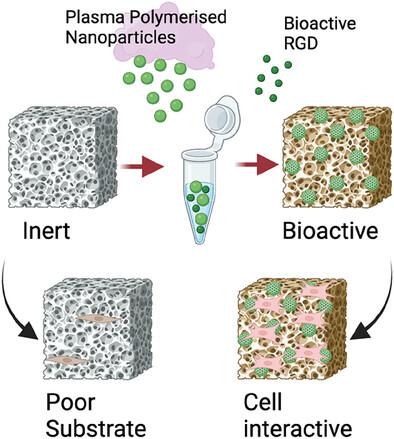当前位置:
X-MOL 学术
›
Adv. Mater.
›
论文详情
Our official English website, www.x-mol.net, welcomes your feedback! (Note: you will need to create a separate account there.)
On-Demand Bioactivation of Inert Materials With Plasma-Polymerized Nanoparticles
Advanced Materials ( IF 29.4 ) Pub Date : 2024-03-14 , DOI: 10.1002/adma.202311313 Miguel Santos 1 , Praveesuda L. Michael 1 , Timothy C. Mitchell 1 , Yuen Ting Lam 1 , Thomas M. Robinson 1 , Mathew J. Moore 1 , Richard P. Tan 1 , Jelena Rnjak‐Kovacina 2 , Khoon S. Lim 1 , Steven G. Wise 1
Advanced Materials ( IF 29.4 ) Pub Date : 2024-03-14 , DOI: 10.1002/adma.202311313 Miguel Santos 1 , Praveesuda L. Michael 1 , Timothy C. Mitchell 1 , Yuen Ting Lam 1 , Thomas M. Robinson 1 , Mathew J. Moore 1 , Richard P. Tan 1 , Jelena Rnjak‐Kovacina 2 , Khoon S. Lim 1 , Steven G. Wise 1
Affiliation

|
Conventional gas plasma treatments are crucial for functionalizing materials in biomedical applications, but have limitations hindering their broader use. These methods require exposure to reactive media under vacuum conditions, rendering them unsuitable for substrates that demand aqueous environments, such as proteins and hydrogels. In addition, complex geometries are difficult to treat, necessitating extensive customization for each material and shape. To address these constraints, an innovative approach employing plasma polymer nanoparticles (PPN) as a versatile functionalization tool is proposed. PPN share similarities with traditional plasma polymer coatings (PPC) but offer unique advantages: compatibility with aqueous systems, the ability to modify complex geometries, and availability as off-the-shelf products. Robust immobilization of PPN on various substrates, including synthetic polymers, proteins, and complex hydrogel structures is demonstrated in this study. This results in substantial improvements in surface hydrophilicity. Materials functionalization with arginylglycylaspartic acid (RGD)-loaded PPN significantly enhances cell attachment, spreading, and substrate coverage on inert scaffolds compared to passive RGD coatings. Improved adhesion to complex geometries and subsequent differentiation following growth factor exposure is also demonstrated. This research introduces a novel substrate functionalization approach that mimics the outcomes of plasma coating technology but vastly expands its applicability, promising advancements in biomedical materials and devices.
中文翻译:

使用等离子体聚合纳米颗粒对惰性材料进行按需生物活化
传统的气体等离子体处理对于生物医学应用中的材料功能化至关重要,但其局限性阻碍了其更广泛的应用。这些方法需要在真空条件下暴露于反应介质,这使得它们不适合需要水性环境的基材,例如蛋白质和水凝胶。此外,复杂的几何形状难以处理,需要对每种材料和形状进行广泛的定制。为了解决这些限制,提出了一种采用等离子体聚合物纳米颗粒(PPN)作为多功能功能化工具的创新方法。PPN 与传统的等离子聚合物涂层 (PPC) 具有相似之处,但具有独特的优势:与水性系统的兼容性、修改复杂几何形状的能力以及作为现成产品的可用性。本研究证明了 PPN 在各种基质上的牢固固定,包括合成聚合物、蛋白质和复杂的水凝胶结构。这导致表面亲水性的显着改善。与被动 RGD 涂层相比,用精氨酰甘氨酰天冬氨酸 (RGD) 负载的 PPN 进行材料功能化可显着增强惰性支架上的细胞附着、铺展和基底覆盖。还证明了对复杂几何形状的粘附力的改善以及生长因子暴露后随后的分化。这项研究引入了一种新颖的基材功能化方法,该方法模仿等离子涂层技术的结果,但大大扩展了其适用性,有望在生物医学材料和设备方面取得进展。
更新日期:2024-03-14
中文翻译:

使用等离子体聚合纳米颗粒对惰性材料进行按需生物活化
传统的气体等离子体处理对于生物医学应用中的材料功能化至关重要,但其局限性阻碍了其更广泛的应用。这些方法需要在真空条件下暴露于反应介质,这使得它们不适合需要水性环境的基材,例如蛋白质和水凝胶。此外,复杂的几何形状难以处理,需要对每种材料和形状进行广泛的定制。为了解决这些限制,提出了一种采用等离子体聚合物纳米颗粒(PPN)作为多功能功能化工具的创新方法。PPN 与传统的等离子聚合物涂层 (PPC) 具有相似之处,但具有独特的优势:与水性系统的兼容性、修改复杂几何形状的能力以及作为现成产品的可用性。本研究证明了 PPN 在各种基质上的牢固固定,包括合成聚合物、蛋白质和复杂的水凝胶结构。这导致表面亲水性的显着改善。与被动 RGD 涂层相比,用精氨酰甘氨酰天冬氨酸 (RGD) 负载的 PPN 进行材料功能化可显着增强惰性支架上的细胞附着、铺展和基底覆盖。还证明了对复杂几何形状的粘附力的改善以及生长因子暴露后随后的分化。这项研究引入了一种新颖的基材功能化方法,该方法模仿等离子涂层技术的结果,但大大扩展了其适用性,有望在生物医学材料和设备方面取得进展。



























 京公网安备 11010802027423号
京公网安备 11010802027423号